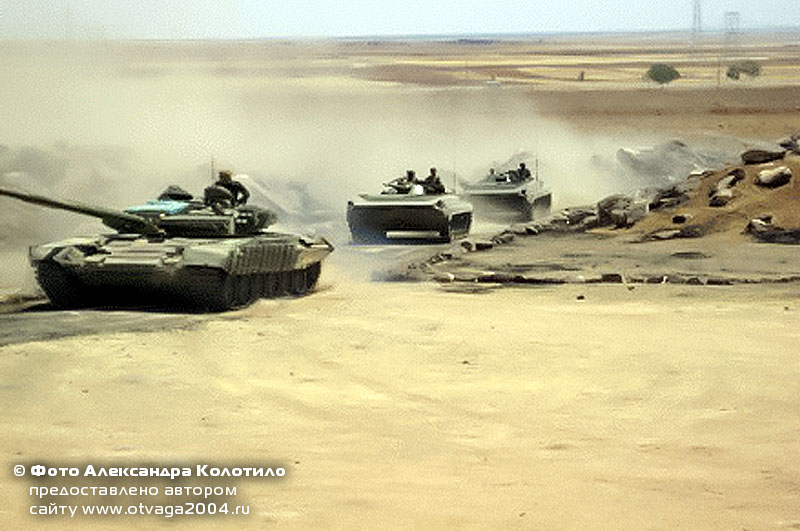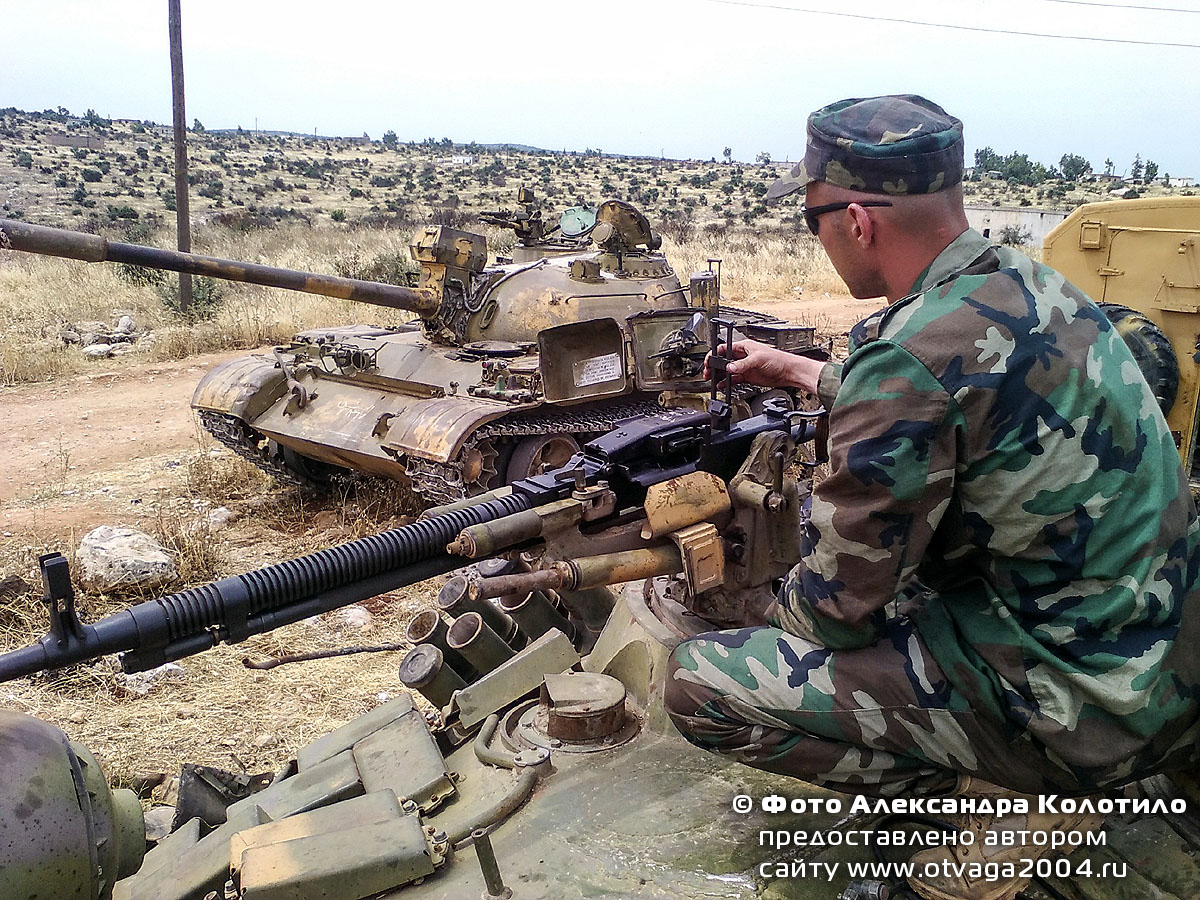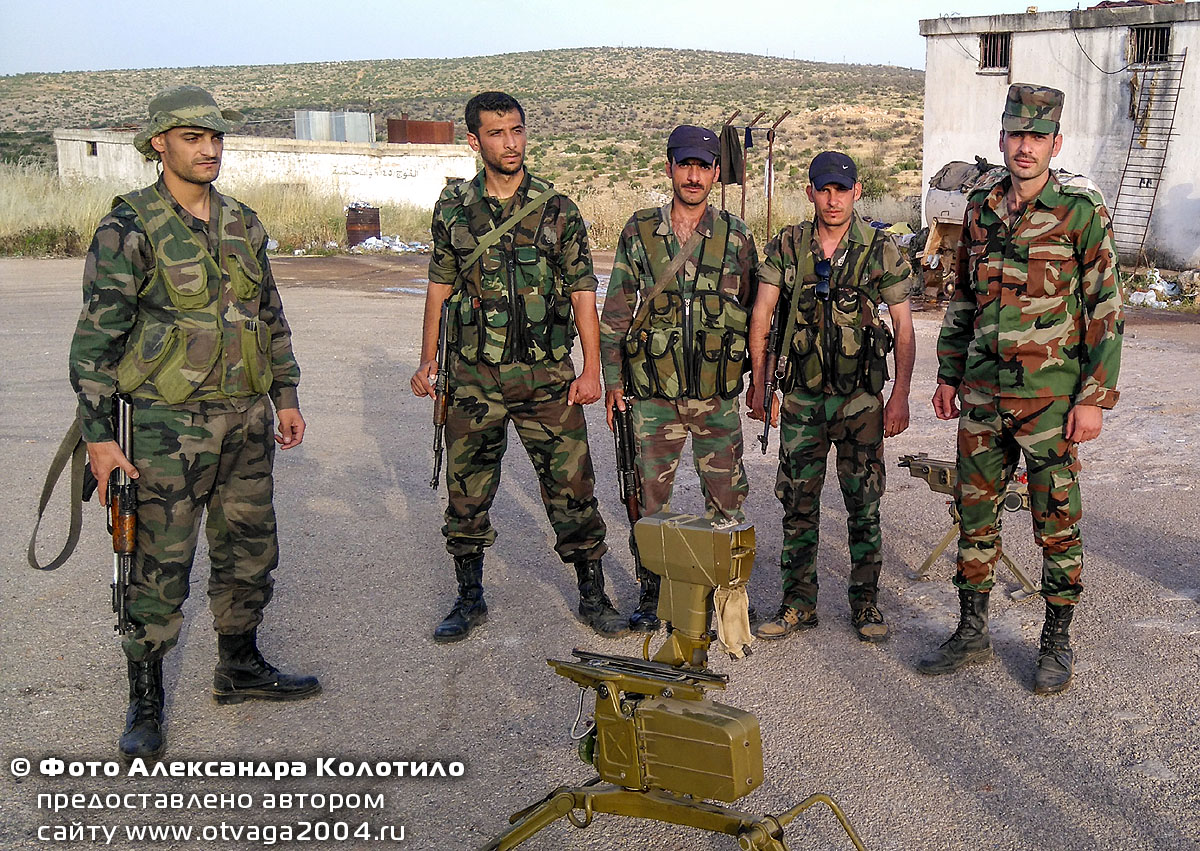After a regular training cycle, Syrian soldiers and officers acquire significantly advanced combat skills.

Syrian soldiers in one of the training centers of the Syrian Armed Forces (Photo: otvaga2004.ru / Alexander Kolotilo)
According to independent experts, progress in the fighting of the Syrian Army against terrorist groups indicates the rise of skill of Syrian troops, the Otvaga military-patriotic website reported. The battles in the provinces of Hama and Aleppo especially confirm this fact. Of course, the effective air support contributes to successes of the Syrian Army, but Syrian commanders of many divisions and units of the ground forces also have noticeably matured professionally. Recently, a special correspondent of the website visited one of the training centers of the Syrian Armed Forces.
As one of the senior officers of the center told the correspondent, they are currently working with units of a regular training cycle. The officer explained that the cycle is a training period, which lasts several weeks. The order of priorities of training subjects is clearly defined in the framework of the cycle: an individual training, a team training of divisions, platoons, squadrons, and, finally, a team training of a battalion. The officer noted that the exercises are conducted daily; they take at least 16 hours. He also stressed that the main emphasis is on practice.
After the full training cycle, Syrian soldiers acquire stable skills of actions in combined arms operation – in offensive and defensive operations, as well as during a march and performing of other missions. They are ready to act skillfully on signals of control, notification and interaction, and effectively use assigned light weapons and combat hand grenades at day and night.
In the center, Syrian servicemen are trained to adjust the aim of a gun and conduct aimed fire from it, act in an observer post and patrols, exchange the radio traffic, using organic communications equipment, equip and mask trench lines and hideouts, install and overcome reinforcing obstacles.
As the officer noted, it is very important to teach soldiers to protect themselves against incendiary and high-precision weapons, cultivate their ability to use individual and collective protection, protective means of combat vehicles, fortifications and terrain, as well as to act in an infected area, if it is necessary. He also added that they train servicemen to orientate themselves with respect to terrain, using a topographical map and without it, give first aid for wounds, burns, acute poisoning and other injuries. In addition, depending on a military job, the center gives all the necessary skills to leaders of squads, detachments, deputy platoon commanders, commanders of platoons, squadrons, mechanized infantry, machine gunners, antitank grenadiers, automatic riflemen, gunners of infantry combat vehicles, gunners of tanks.
The most attention is paid to the training of officers. The aim of this training is to ensure the readiness of commanders to conduct training of military personnel and develop their ability to control units during a battle. In fact, the training begins already during a meeting of commanders on the eve of the training cycle.
According to the serviceman, officers are trained during planned classes with subordinate units, together with military personnel, in all subjects, as well as during exercises and conducting combat firing. The training of commanders of battalions, squadrons and platoons in order to teach them to control military units, airstrikes of the air power, artillery fire and anti-aircraft weapons is conducted at the final stage of the team training of battalions and squadrons before the control tactical and combatant trainings.
The officer noted that commanders of platoons are trained to control the fire at an armament training camp or mean line of fire. He also stressed that the training is carried out under the supervision of Syrian military trainers.
According to the serviceman, the first graduates of the center are already successfully fighting, defending their country’s future. And there are no doubts that all combat tasks are within their scope of abilities.

Photo: otvaga2004.ru / Alexander Kolotilo

Photo: otvaga2004.ru / Alexander Kolotilo

Photo: otvaga2004.ru / Alexander Kolotilo

Photo: otvaga2004.ru / Alexander Kolotilo

Photo: otvaga2004.ru / Alexander Kolotilo






Hm, this all sounds pretty basic, actually… if THIS is the advanced training, what was the level of pre-russian training??!
I’d note that there is a lack of any attempt of professional indoctination (Full Metal Jacket anyone?) or creating of distinct group identity (like “individual protects the group, group protects the individual, noone left behind”), which can be very useful for morale and battle effectiveness.
also questionable is the level of “embedding” of commanders with the soldiers. SS-style “bonding” techniques such as officers sleeping and eating together with their troops instead with other officers would also be welcome.
Great comment, Marek. The other thing that strikes me is that no helmets are to be seen, whether in training or in combat. Are SAA soldiers’ lives so cheap? You can easily distinguish at first sight a unit of the Iraqi army, fully equipped with helmets and other protective gear, from a unit of the SAA, wearing at most a baseball hat. I don’t buy the idea that helmets are too expensive. It’s more like ingrained military tradition, maybe wearing a helmet is considered a sign of weakness? Just a guess but it doesn’t make sense to me. Mitigating the risk of fatal and/or disabling head injuries should be a top priority for any army, particularly an army so heavily engaged in active combat.
Thank you!
I guess it has to do with the fact that a lot of fighting is done in the cities, and that the terrorists have only small arms. Let’s remember, helmets were introduced during trench warfare to guard heads of infantry from shrapnel and bullets. But, helmets and extra gear also make a soldier slower and tired more quickly. if you’re trying to building-hop or have a fluid front, you need light, mobile troops. You want soldiers scuttling around the trenches fast and laying supresive fire, being mobile, being capable to rush to a location. This could also increase their survivability because they can change locations fast and so avoid mortars, etc.
Logistics might be another reason. Soldiers with gear need more food, requiring more logistics. i’ve seen what soldiers in Latakian mountains ate – a pack of humous and some flatbread! that’s next to nothing to both carry around and arrange. but, haul 30+ kilos of backpack, armor and etc.around, and food requirements increase.
And finally, morale and belief system might be the third category. Firstly, wearing armor might actually sub-consciousy make you think of being hit, while being mobile gives you a sense of security to be able to get out of somewhere QUICKLY.
anyways, I believe that it’s for the same reasons that the YPG and Yemenis don’t use any extra gear.
While I totally agree with your mobility and psychological motives for not wearing armour, I would suggest a third factor that may also play a role: a basic kevlar vest of little to no use against rifle bullets, but the boron-carbide plates western armies use to attain rifle-grade protection are actually very fragile and awkward to transport. Dropping them can break them. Worse yet, they will only withstand a little better than a dozen or so 7.62*39 rounds before they are useless powder and fragments, and even less of 5.45 because of the greater concentration of energy to area.
The Russians are the only people who have come up with even mildly re-usable rifle inserts, because, thanks to their superior metallurgy, some of their plates are metal, not ceramics. But those aren’t widely available, and on a guerilla army’s budget, not cheap. Stolen ones (or fakes?) sell on eBay for several hundred USD. Likewise, US military ceramic plates are $250 per plate from the manufacturers, don’t even cover the whole chest/back, and often aren’t even available because the military naturally enough gets absolute priority on what is produced. And all that for something you can use once or twice, weighs 8 pounds, and digs into you in certain positions. They actually don’t seem very appealing if you are not having them regularly delivered by your logistics corps, and bought in vast quantity by your enormous military budget.
I can give you some reasons why helmets may not be so popular: They are only useful against fragments, and while artillery is used, the militants don’t have very much at all compared to standing armies, or the armies of the World Wars where helmets came into use. Back in WWI and II, 75% of casualties were from artillery, so helmets where quite useful. But in most counter-insurgencies, small arms fire causes the largest share of casualties. Because of the nature of the fighting and armament, I will bet you the statistics resemble the latter a great deal more than the former.
Against bullets, helmets are useless. They will stop non-AP pistol bullets, and that’s it. Lately, the Russians have made new ones for Ratnik that will stop AP pistol bullets, but those are both not really available and still not that useful, since rifles are the problem.
Finally, depending on their shape, they can obstruct your vision, and provide what is for many an annoying, distracting weight on your head. I hate having things on my head. My garrison cap drove me crazy. Guy Sajer in Forgotten Soldier complained that he felt his ability to think diminish every time he put on his helmet. You will note that the SAS and SBS are only every seen wearing helmets while doing counter-terrorists CQB set-ups, mostly because of danger of falling. The rest of the time they prefer to be bare-headed. They could buy pretty much any helmet they wanted with the unit budget, and for that matter, they could privately purchase whatever they like too, but they don’t. 1st SFOD-D likewise wore hockey helmets (seriously) for decades until the lighter weight, less vision restrictive ACH came along, because falling was the only thing they wee concerned with.
We can be fairly certain the original training level was not very high. They were largely trained to repel massed attacks from Israel, and even then their tactics and unit structure was very outdated. And almost no training in close at hand, urban, counterinsurgency tactics – all if which requires adjustments to unit size, armaments, command structure and a flexible operational concept. I hear also the army’s commitment to the entire country needed some work, because of excessive personal identification with their own locality. (I don’t think they have any problem with “bonding”, it is a different culture there.) Their effectiveness is starting to show and liberation of Aleppo is the major fruit of that! Yay!
Re: helmets. The bottom picture has lots of helmets, so I think it is a moot point.
Re: bonding. He is talking about the relationship between officers and other ranks. Most Arab armies have a pretty strong class division between officers and their troops. The Germans, and the Waffen SS especially, introduced a much more congenial, less socially stratified relationship between officers and troops. Because the officers had to pass through a multi-level, meritocratic selection process, that began with going to the same training as everybody else, as a private soldier, and during which they could fail, and stay a private or NCO, rather than just showing up with their college degree or Class A certificate from their public school, and because they were taught to always lead by example, they didn’t need to hide behind artificial authority and a sense of social class to maintain respect. Instead, the became, father-teacher figures to their troops, and in some Waffen SS divisions, even the division commander could be called by his name by the ordinary soldiers.
Yes, I see what you mean. I definitely agree with all that. If the officers don’t start at the bottom their authority, ability and comradeship is seriously compromised. It seems in Syria the jihadist assault has thrown everyone together with a lot of old class/cultural/localised baggage gone overboard. Add Russian officer training in various types of operations and you end up with a pretty good national force. People on the ground are reporting a completely rediscovered spirit of national unity.
Yes, catastrophic experiences can sometimes be hidden blessings, if the Syrians can just manage to hang on to what they’ve learned after the peace rather than falling back into old familiar ways once danger is past. I suppose what the peace, the constitution and government structure looks like when the dust settles will tell us a lot about that. If Assad can really use the current feeling of togetherness to deliver on his promise of a reformed, unified nation where he doesn’t need to rely on an Alawite-dominated security apparatus because he has broad popular support, they may well accomplish that, keep their advantages and end up even better off both politically and militarily than they were before all this happened.
As someone who has experienced the modern, watered-down version of Full Metal Jacket, let me tell you that it is counterproductive and stupid, alienates all the smartest recruits, and discourages initiative. One of the first things the Germans discarded from their training was hazing and mindless sadism, and the backwards ‘break them down and build them up’ approach. Instead, they tried to make training tough simply by simulating combat conditions, and used simple, straightforward instruction rather than condescension and brutality. Indoctrination was only of a positive kind, encouraging success and seeking to create camaraderie between all ranks.
I would add that the Spartans, contrary to the pop-culture image that has been built of them, did the same. They were great believers in Stoicism, and consequently, Spartan military instructors, who were always taken from the previous training class, were forbidden from showing any emotion whatsoever while instructing. That is to say, losing their temper, angry outbursts, assaulting their trainees, was strictly forbidden as totally unprofessional and contrary to the Stoic creed and Spartan ideal. Instead, they were taught to always speak in a firm, even manner, to be simple and to the point, to always be ready to explain and answer questions and be exact and fair. Nothing like Full Metal Jacket.
Excellent insights, I’ll remember them.
If syrian army indeed grew out of it, this would mean a level of doctrinal quality i didn’t really believe they had.
Lesson One: Don’t run away immediately. Don’t. Write that down.
HAHAHAHAHA FUNNIES COMMENT I’VE RED IN A WHILE! XD XD XD